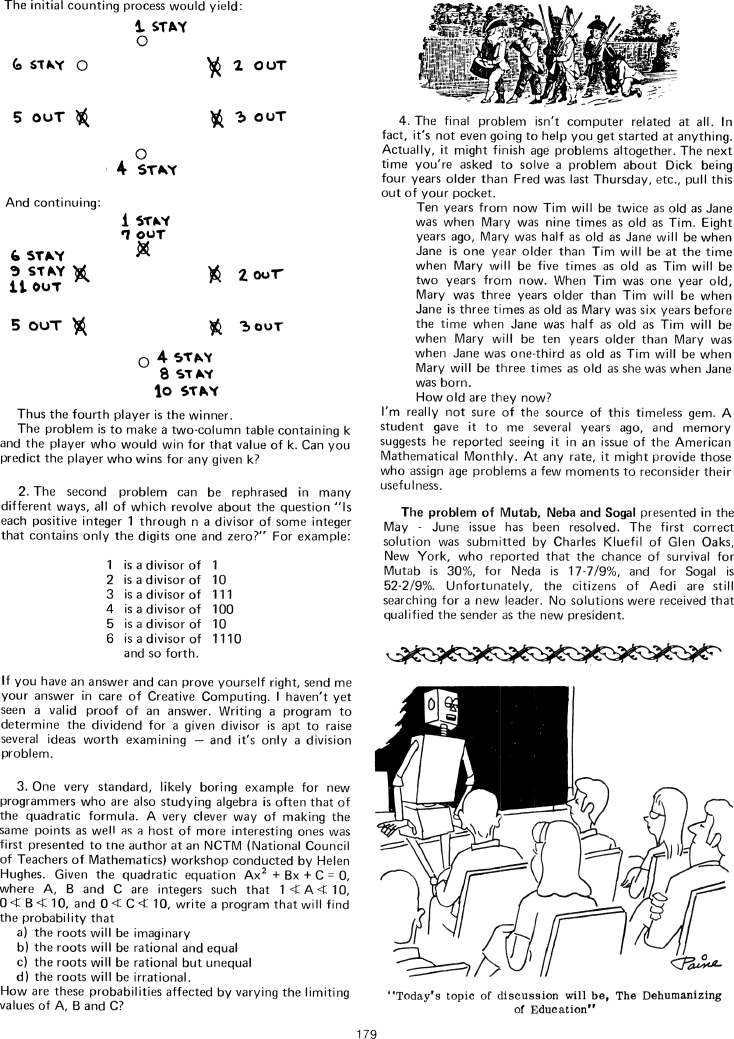The Best of Creative Computing Volume 1 (published 1976)
Reading, Writing, and Computing

The initial counting process would yield:
[image]
And continuing:
[image]
Thus the fourth player is the winner.
The problem is to make a two-column table containing k and the player who would
win for that value of k. Can you predict the player who wins for any given k?
2. The second problem can be rephrased in many different ways, all of which
revolve about the question "ls each positive integer 1 through n a divisor of
some integer that contains only the digits one and zero?" For example:
1 is a divisor of 1
2 is a divisor of 10
3 is a divisor of 111
4 is a divisor of 100
5 is a divisor of 10
6 is a divisor of 1110
and so forth.
If you have an answer and can prove yourself right, send me your answer in care
of Creative Computing. I haven't yet seen a valid proof of an answer. Writing a
program to determine the dividend for a given divisor is apt to raise several
ideas worth examining - and it's only a division problem.
3. One very standard, likely boring example for new programmers who are also
studying algebra is often that of the quadratic formula. A very clever way of
making the same points as well as a host of more interesting ones was first
presented to the author at an NCTM (National Council of Teachers of Mathematics)
workshop conducted by Helen Hughes. Given the quadratic equation Ax2 + Bx + C =
0, where A, B and C are integers such that 1 < A < 10, 0 < B < 10, and 0 < C <
10, write a program that will find the probability that
a) the roots will be imaginary
b) the roots will be rational and equal
c) the roots will be rational but unequal
d) the roots will be irrational.
How are these probabilities affected by varying the limiting values of A, B and
C?
[image]
4. The final problem isn't computer related at all. In fact, it's not even going
to help you get started at anything. Actually, it might finish age problems
altogether. The next time you're asked to solve a problem about Dick being four
years older than Fred was last Thursday, etc., pull this out of your pocket.
Ten years from now Tim will be twice as old as Jane was when Mary was nine times
as old as Tim. Eight years ago, Mary was half as old as Jane will be when
Jane is one year older than Tim will be at the time when Mary will be five times
as old as Tim will be two years from now. When Tim was one year old,
Mary was three years older than Tim will be when Jane is three times as old as
Mary was six years before the time when Jane was half as old as Tim will be
when Mary will be ten years older than Mary was when Jane was one-third as old
as Tim will be when Mary will be three times as old as she was when Jane was
born.
How old are they now?
I'm really not sure of the source of this timeless gem. A student gave it to me
several years ago, and memory suggests he reported seeing it in an issue of the
American Mathematical Monthly. At any rate, it might provide those who assign
age problems a few moments to reconsider their usefulness.
The problem of Mutab, Neba and Sogal presented in the May - June issue has been
resolved. The first correct solution was submitted by Charles Kluefil of Glen
Oaks,
New York, who reported that the chance of survival for Mutab is 30%, for Neda is
17-7/9%, and for Sogal is 52-2/9%. Unfortunately, the citizens of Aedi are still
searching for a new leader. No solutions were received that that qualified the
sender as the new president.
[image] "Today's topic of discussion will be, The Dehumanizing
of Education"


